日本語版はこちら(Japanese version is here.)
This blog is about the tragedy that occurred on the Nakagawa Railway Bridge in Anan City, Tokushima Prefecture at the end of the Pacific War. We have created an English version of this blog to share this history with English speakers living in Tokushima Prefecture, as well as those residing outside the prefecture who are interested in this railway bridge’s history.
Staff Blog Special Edition Burari-bashi (Nakagawa Railway Bridge Air Raid)

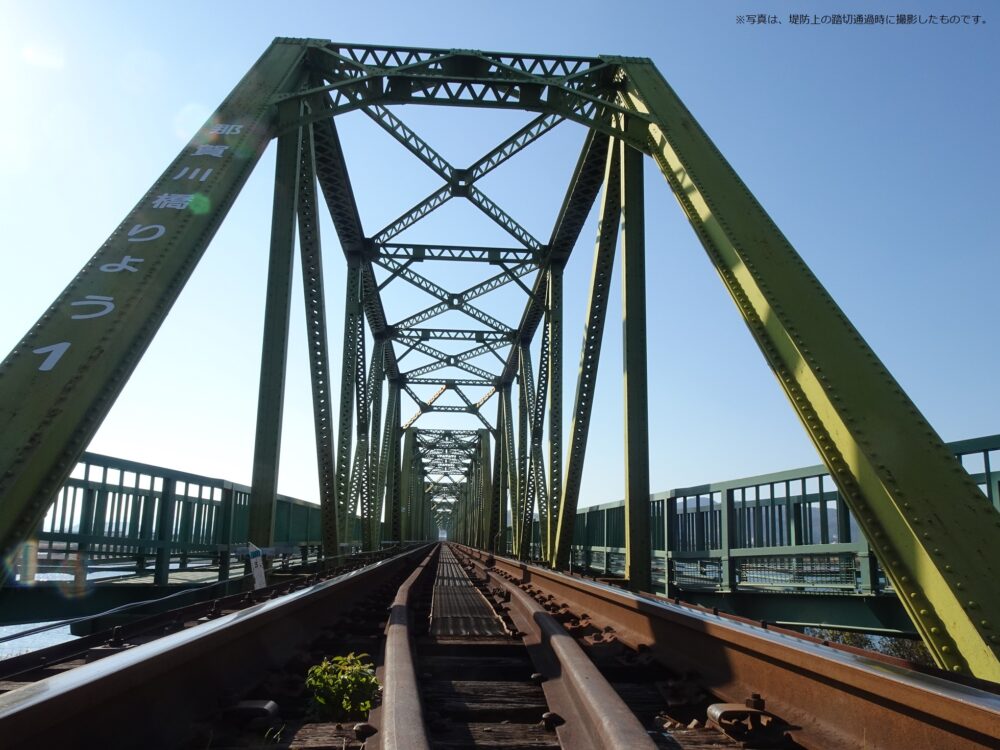
Takako Fukuzaki used to commute by train from Hanoura Station to the girls’ school in Tomioka. To reach school she had to cross the newly constructed Nakagawa Railway Bridge, which just opened in 1936. Tomioka Station (now Anan Station) was where she used to get off the train, however on that summer day, she did not take the usual train. Instead, she went out for labor service.
Her role was to help build an air-raid shelter in the area. In early July, Tokushima City was engulfed in flames.(*1) This could be seen all the way from Anan. As she continued to work, she struggled to get the image of burning skies out of her head.
That day was a summer day, July 30th, 1945, only 16 days before the end of the Pacific War. The “Nakagawa Railway Bridge” is the longest steel bridge on the JR Mugi Line, spanning the Nakagawa River. It is approximately 471 meters long and spans the river near the river’s mouth. Nobody imagined that this railway bridge would become the stage for this tragedy.
The train bound for Mugi departed Tokushima at 2:47 p.m. The fully loaded four-car train stopped at Awa Nakashima Station, waiting for the order to depart for Tomioka Station.
At this time, the passengers and station staff had no way of knowing that the Corsair (fighter aircraft) departing from the U.S. Navy aircraft carrier Hancock, was heading toward Anan over the Kii Channel.(*2)
At the station master’s discretion, the train leaves before 4:00 p.m. After leaving the station, the black steam locomotive turns sharply to the right while towing passenger cars, and slowly starts to climb toward the bank of the Nakagawa River. After climbing up the sloping railroad tracks, the bridge comes within sight.
When the lead locomotive reaches the first girder, two fighter aircrafts swoop down from the sky with a loud explosion and strafed at the train. The train stalled. Some of the last cars are still on the viaduct next to the bank. Passenger cars are targeted with no remorse. Blood curdling screams, panic, and people running away can be heard.

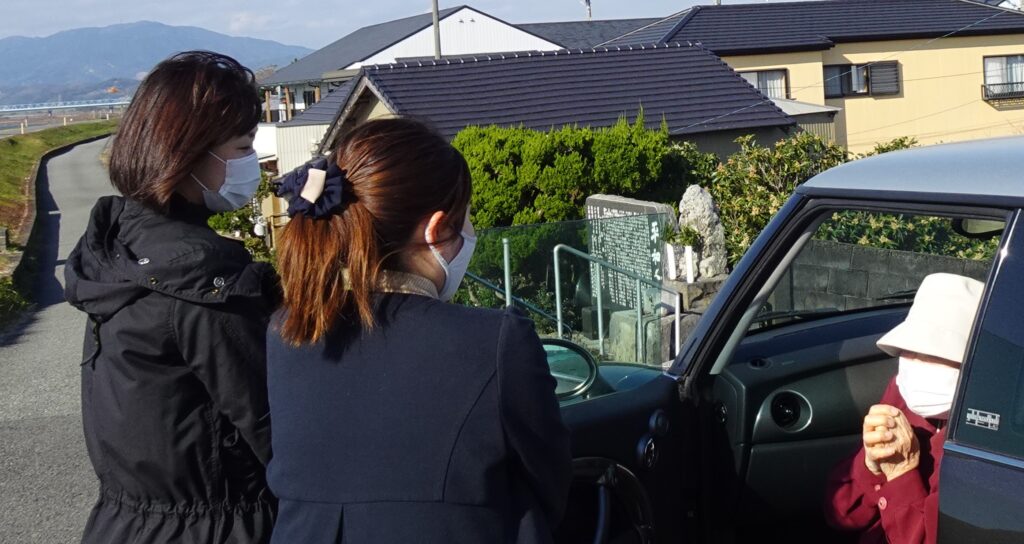
It has been 75 years since that day. We had the opportunity to listen to her in front of the “Peace Monument”; a stone monument erected near the north abutment of the Nakagawa Railway Bridge.
This monument was erected in 2005 by the Nakagawa Town Women’s Association to commemorate the 60th anniversary of the end of World War II. The monument’s inscription conveys the severity of the tragedy.
Fukuzaki and Nobuko Kori, worked together in the Women’s Association to create “Kamishibai” show based on this tragedy.
“Kamishibai” show means a picture-story show. A scene of a story is drawn on thick drawing paper, and an explanation of the scene is written on the back. The number of drawing sheets is determined according to the length of the story. In front of a large group of children, the narrator explains the scene behind the drawing paper and says the characters’ lines while showing the picture.
They travel together and share the tragedy and severity of war at nearby elementary and junior high schools. We had the opportunity to hear about this story directory from Fukuzaki.
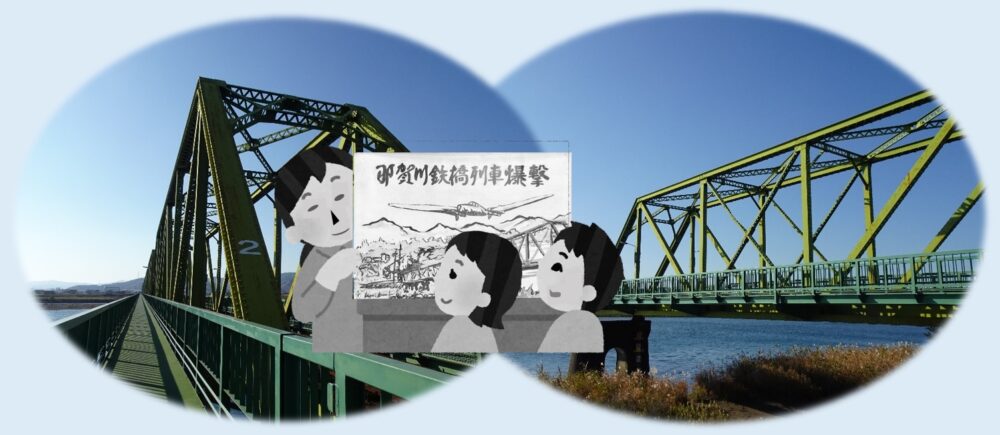
How old were you at the time , Ms. Fukuzaki? When did you learn about this story?
I was 15 in the middle of my third year of the girls’ school. During this time middle school aged boys and girls got to either a boys or girls school.
I heard a couple of days later that a terrible incident had occurred on the bridge, killing more than 30 people. I was still a child at the time , and unlike today, the news was not immediately reported.
Did you hear about this day from anyone who was on that train?
Yes, I did. My friend Ms. T. told me what happened. She always took that train from Hanoura station. She was on the train trying to go see her grandmother who lived in Tomioka. Fortunately, she was not injured, but when she was desperately trying to escape, someone else grabbed her legs in an attempt to escape. In that moment her own safety was more important, so she shook off the hand and ran to safety. There was nothing else she could do, but to this day, she still cannot forget this moment.
We were rendered speechless by Fukuzaki’s story.
The lead locomotive probably did not have any severe damage. I heard that it was able to run on its own and arrived at Tomioka station. I heard that some people were wondering why the coaches hadn’t arrived yet.
What made you decide to begin telling this story using “Kamishibai”?
When Ms. Kori was the president of the Women’s Association at the time, we were thinking about what we could do as a Women’s Association to share this story. We ended up coming up with the idea of a “Kamishibai” show. We asked Mr. H: a local teacher I knew, to illustrate the pictures of “Kamishibai”. I was impressed with how well he drew the pictures, even though I had only given him the scenario of the story.
What was the reaction of the audience when you did the “Kamishibai” show?
There were many audience members watching the performance in tears. It may be difficult for children living in a peaceful era to imagine the contents of this moment in time. Nevertheless, I would be very happy if the “Kamishibai” show could help children think about how precious peace is and the importance of life when they see this bridge.
This tragedy took place in 1945. So, when you think about it, it wasn’t that long ago. This bridge acts as a silent narrator, conveying the hardships of this time.
I think it is our responsibility as war survivors to convey the tragedy and irrational nature of war. Until 7 years ago I was sharing the history through performing at schools, but due to my age I have stopped doing it. I hope that the younger generation will be able to protect this peaceful Japan forever.
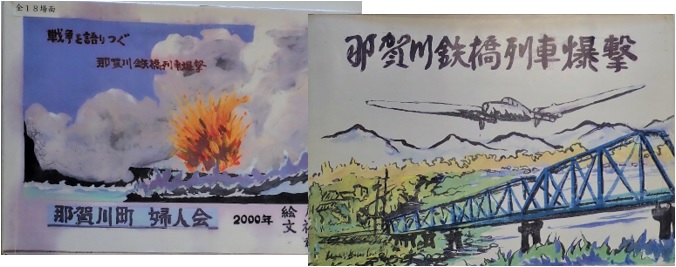
The original “Kamishibai” is currently stored at the Nakagawa Town Community Center. We were shown the pictures at a later date. The horrific event of that day was depicted in first person. These images convey the unimaginable horror of those unfortunate enough to be on the train, and the regret of those who died.
Until Fukuzaki’s talk, we had known about the Pacific War as a piece of history, but to be honest, we had always imagined that it happened long before we were born. However, Fukuzaki who lived through the war years reminds us of the importance of preserving peace through her strong words.
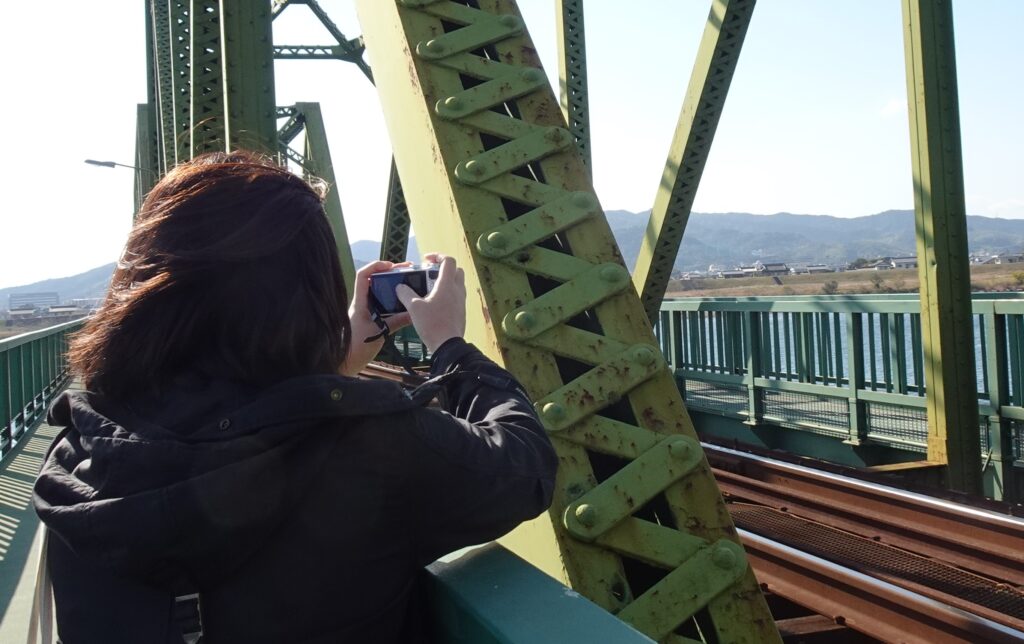
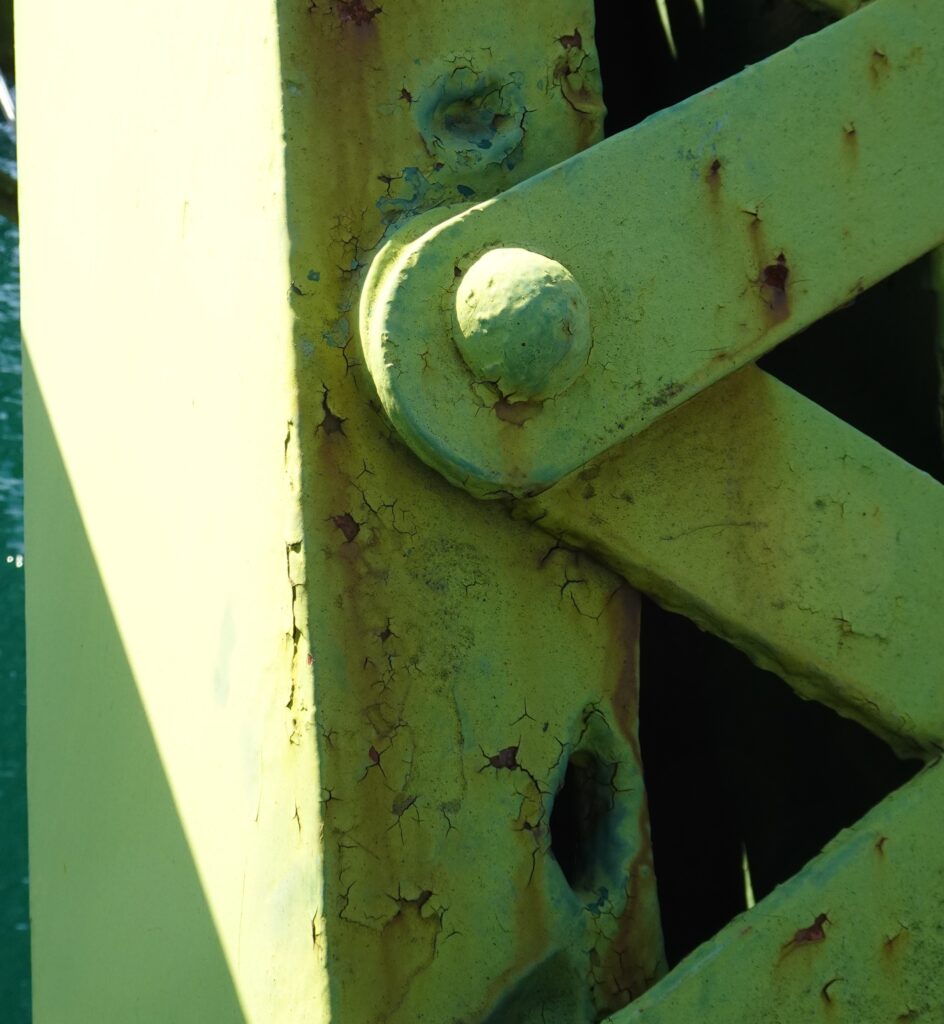
Even now, many marks from a low-level strafing fire can be seen on the railway bridge.
The second girder from the north side of the bridge still has many bullet holes in it. The bridge has an attached pedestrian walkway (*3) on both sides, so pedestrians can see the bullet holes from either direction. Those interested in seeing this history can take their time looking along the walkway.
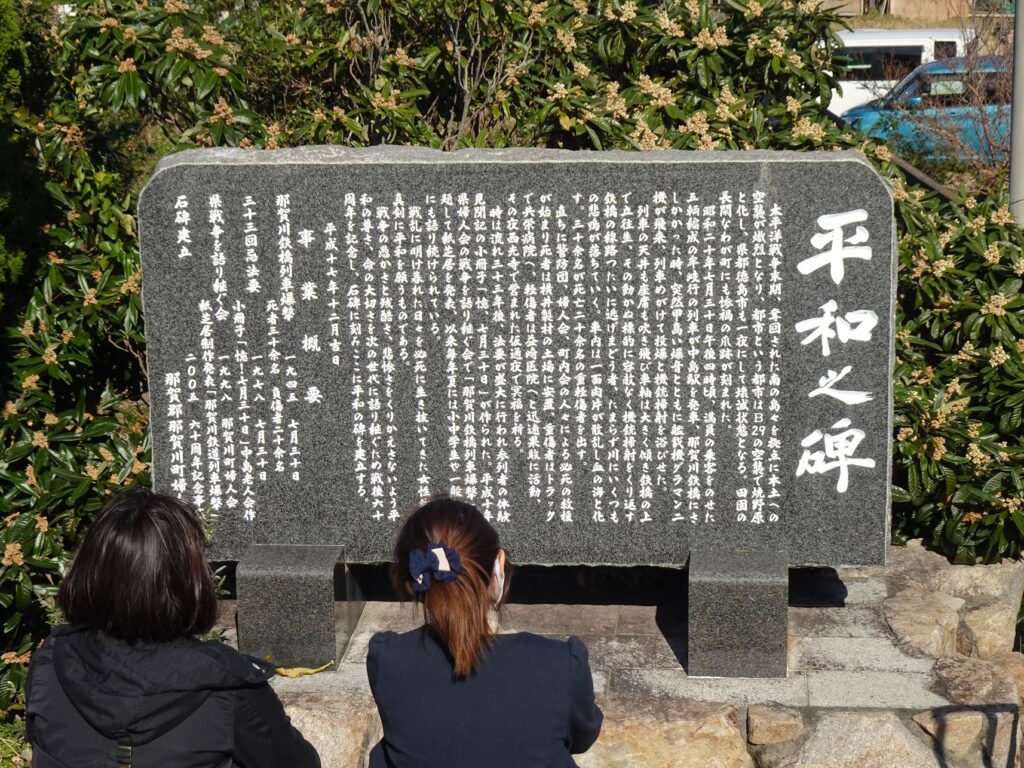
(*1)
In the early morning of July 4, 1945, 129 B-29s flew over Tokushima City from the mouth of the Shinmachi River and dropped incendiary bombs on the city for about two hours. According to Tokushima City, about 62% of Tokushima City was burned down by the raids, and about 1,000 people were killed and 17,183 households were affected. Eyewitnesses state that the air raids of that day were visible from Anan City and even from Sadamitsu Town(now Tsurugi Town).
(This explanation is based on Wikipedia, Tokushima Air Raid)
(*2)
According to a historian researching US documents about Allied operations at the time, there were F4U Corsair(Fighter Aircraft), which departed the aircraft carrier Hancock at 2:00 p.m. July 30th, 1945, and returned at 6:15 p.m. The Fighters inflicted damage to the locomotive through strafing fire. The original mission of these aircrafts was a “mop-up operation” (search and destroy), but it was changed to a search-and-rescue operation code-named “Dumbo,”. It is said that they searched for a new attack target where they could use the bombs they were carrying.
(*3)
The “Nakagawa Railway Bridge” is a very rare railway bridge that has pedestrian walkways on both sides. According to the history of the town of Nakagawa, at the time, the only way to cross the river was through a prefectural ferry in the vicinity that served as a prefectural road. But, there were many cases of people walking across the track of the bridge, resulting in accidents. In response, Tokushima Prefecture and the Shikoku Bureau of the Japanese National Railways (JNR) discussed the issue, and in 1973, the prefecture added a pedestrian walkway. The attached walkway is managed by the prefectural government as a prefectural road under a management agreement between Tokushima prefecture and JR Shikoku. Since it is a pedestrian walkway, only pedestrians and bicycles are allowed to pass.
Acknowledgements
We have created this blog with the help of Ms. Takako Fukuzaki, and Ms. Kazuko Fukuzumi, the current president of the Nakagawa Town Women’s Association. Thank you very much for your cooperation.
We would also like to thank Mr. Ahren Lucchini for his cooperation in English translation.



